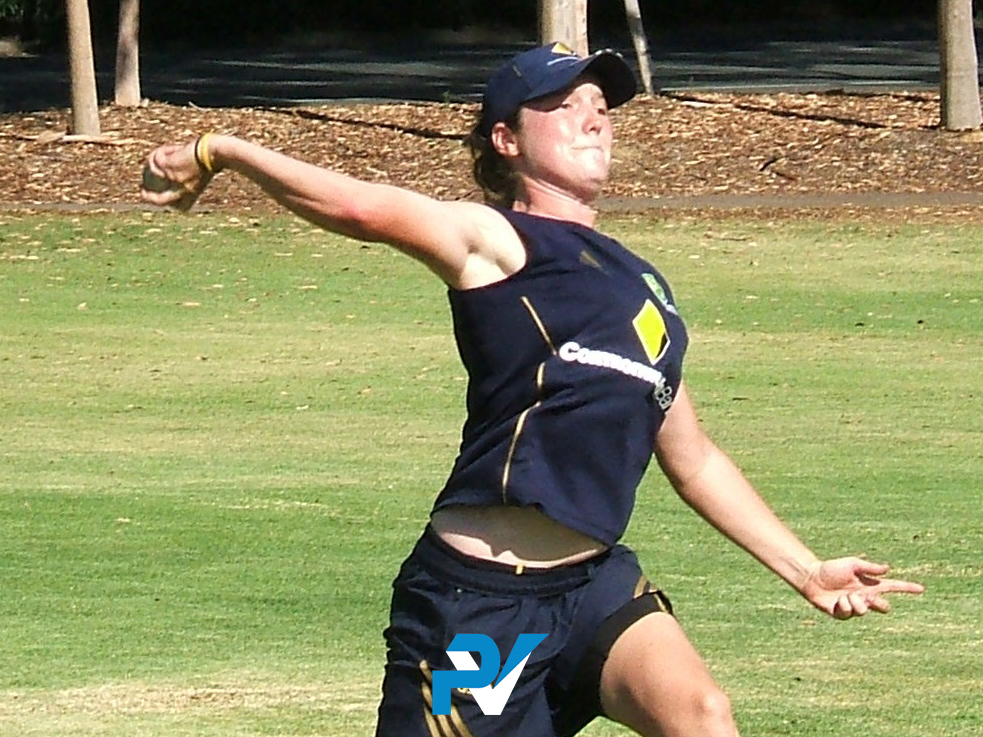How to Have a Bullet Throw
 A powerful throw sends a message to a batting team.
A powerful throw sends a message to a batting team.
The batsmen are looking for a second run and you are in the deep. The both look up to see your throw, as do most of the batsmen waiting to come in. There is a subtle moment of expectation: Just how good is this guy’s throw?
You sear it in head high, dipping into the keeper’s gloves so he doesn’t have to move.
Use "Power Positions" to Throw Harder with Less Injury Risk

We had a wonderful throwing based question from Peter on the podcast recently. Peter was coming back from injury of the shoulder and looking to build a throwing technique which would take pain away from that area.
I suggested that he made his throwing action more efficient. This increases power and significantly reduces the chance of throwing injury. So, what does this look like?
How to Measure Fielding Effectiveness in Training

In a game that is full of stats, we are still searching for a way of assessing and measuring fielding effectiveness.
Fielding Drill: Tennis Inspired Pick Up and Throw

Kate Warne-Holland - Millfield's fantastic Director of Tennis - recently ran a drill that inspired me to adapt it for cricket.
Become Fielding CEO and Watch Your "Stock Price" Rise

When I was Head Coach of Somerset, my main intention was to develop a fielding unit that would smash all others out of the park.
We worked significantly on our positioning, our specificity with specialist deep fielders, "box men " and slips. We ensured that everyone could high catch and dive in an effective fashion. We focussed on our high traffic area fielders being excellent stump hitters.
Increase Catching Area with this Funky Drill
 How big are your players catching areas?
How big are your players catching areas?
Super slow motion cameras are great for noting the size of catching areas in both keepers and fielders. Often, we see that catchers line the ball up with one open hand and more closed one, this is great if judgement is spot on or if the ball does not dip or deviate in the air.
How to Use Airlines to Improve Outfielding

A mate of mine used to fly for one of the budget airlines. He let me into a secret about their landing strategies; they come in very steep in their descent and land heavy, often bouncing a little on the runway before all the wheels are rolling smoothly on the tarmac. The reason, so he claims, is to save fuel. Less time in the air equals less fuel burned.
Slide, Dive, Collide: How to Avoid Boundary Catastrophe

Fielding in pairs.
Boundary riding.
Assisted catches.
These are common terms in the modern game. The best players playing with the best players in the IPL and the BBL have bought this to the forefront and we see some incredible fielding feats on club and school cricket grounds all across the world.
However, in the Regional T20 Semi Final of the National T20 Tournament the other day, I saw 2 separate collisions as two fielders both hurtled towards the ball with the same intention. To dive and stop the ball!
The commitment was huge and cannot be faulted. Yet, on another day we could have had a much worse outcome. One of the players cracked rib could have been a lot worse and the head injury could have been hideous.
So how can we help boundary riders to perform their skills and stay safe?
Wicketkeeper Standing Back Drill: Relevant, Functional and Challenging

The challenge with any wicket-keeping drill is to make it relevant, functional and challenging.
Last week, we were doing a standing back drill using the Katchet board. I was throwing the ball onto the board as hard as I could to challenge the two keepers. The keepers are both County Age Group players and in one of the cases, an England International.
It soon became apparent that both were not being challenge sufficiently by the drill and that my shoulder was getting warmer and warmer. We needed to solve a problem.
That solution was the Sidearm. Since a recent Sam Lavery article on coaching kit, I have noticed more players have purchased Sidearms. It's great to see sessions where players are practising batting in pairs against the sidearm. It’s a brilliant piece of kit.
I decided to ease my shoulder by attempting to throw the ball onto the Katchet using a Sidearm. The results were awesome.
Here's my view,
Fewer Byes: Wicketkeeping Problems Solved

If you have ever kept wicket then you will know that most of the balls that disappear past you for byes end up going under the line of your gloves, and most balls that you drop hit the end of your fingers rather than smacking securely into the palm of your hand.
"Stay Down! I’ve told you before, stay down!"
How many times have I heard this coaching input?
The answer is too many. The statement doesn't help at all. So what should we do as a keeper or advise as a coach?
The keeper needs some options that leads to her to stay down longer and ultimately, to help her to come up with the bounce of the ball.
We can take a technical approach, an intention based approach or a combination of the two to get the desired effect.

